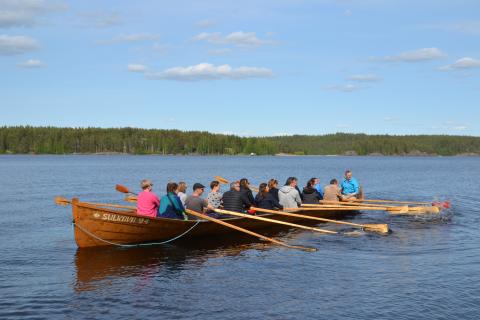Unveiling the rural charm of South Savo, Finland

CASPER firmly believes that even with decreasing populations, rural regions can still thrive and offer a high quality of life.
During our project meeting in Savonlinna, Finland, our partners and their stakeholders got to visit and interact with the smaller municipalities of the South Savo region to understand what makes a region, and what works for them.
Savonlinna as a technology hub
Savonlinna is a hub for tourism and water-borne traffic, and – with the establishment of Technology Park Noheva – R&D in lake Saimaa. Noheva is home to environmental, advanced biotech, and agricultural technology, and unites big actors in the Finnish environmental research ecosystem. In addition to advancing future technology, Noheva’s presence in Savonlinna also means job creation and talent retainment in the region.
Puumala and the 12-year mission to become debt-free
Puumala, under the leadership of mayor Nina Kuuva, has undertaken remarkable steps to rejuvenate its economy. Notably, the 2011 tax reform bolstered tax revenues by more than €700,000 annually, while the Archipelago Municipality supplement provided an additional €815,000 per year. These financial injections have played a crucial role in creating a stable economic foundation. Over the past decade, the town has consistently achieved positive net gains, with a 12% in moving profit recorded in 2022.
Equally vital has been the municipality's collaborative approach with neighbouring towns such as Mikkeli, Sulkava, Savonlinna, Rantasalmi, and Juva on pooling resources and sharing services like library, business, and environmental health services. The municipality also has a strong third sector, which carries out cultural, sports, and environmental services such as maintaining forest trails and organising art camps for children.
Sulkava and the tradition of church boat rowing
Sulkava is a small town with a population of 2400, with roughly less than half are of working age. However, in July, during its signature annual rowing race Sulkavan Suursoudut, the town attracts over 30000 participants and visitors. In addition to the obvious economic and tourism boost, the race also strengthens the sense of community, uniting participations from the municipality, local entrepreneurs, volunteers, and participations.

South Savo and second-home tourism
The Finnish Lakeland nature – well known for its forests, water, and silence – attracts a lot of second homes. And Puumala and Sulkava are not exceptions. Finns go to their second homes to let go of their daily routines, enjoy a more silent, slower, and more modest lifestyle, spend time in the wild, and collect the summer delicacies the Finnish forests have to offer. Second homes provide income to local businesses, tax incomes to local municipalities, and help stabilise housing prices in the region.[1]
In Puumala, the presence of approximately 4000 summer residents or second homes significantly bolsters the local economy during the warmer months, effectively doubling the population. The municipality's focus on extending the duration of these seasonal stays underscores a commitment to fostering year-round economic activity. Notably, a weekly summer calendar was devised in collaboration with local businesses, offering a range of activities and events for seasonal visitors.
Many thanks to the staffs at Technology Park Noheva, municipalities of Puumala and Sulkava for their times, and our partners at the South Savo Regional Council for organising the site visits!
[1] Adamiak et al. (2015). Second home tourism in Finland – Perceptions of citizens and municipalities on the state and development of second home tourism. https://www.researchgate.net/publication/278029787_Second_home_tourism_in_Finland_-_Perceptions_of_citizens_and_municipalities_on_the_state_and_development_of_second_home_tourism
